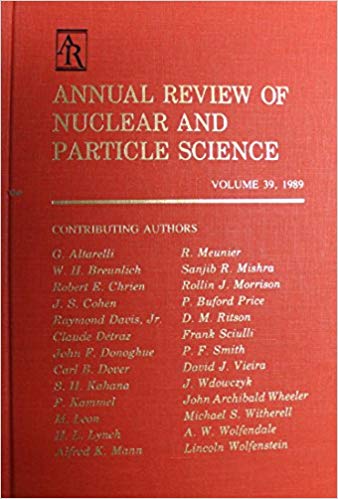Polarization and Vorticity in the Quark–Gluon Plasma
IF 8.4
2区 物理与天体物理
Q1 PHYSICS, NUCLEAR
Annual Review of Nuclear and Particle Science
Pub Date : 2020-03-07
DOI:10.1146/annurev-nucl-021920-095245
引用次数: 118
Abstract
The quark–gluon plasma (QGP) produced by collisions between ultrarelativistic heavy nuclei is well described in the language of hydrodynamics. Noncentral collisions are characterized by very large angular momentum, which in a fluid system manifests as flow vorticity. This rotational structure can lead to a spin polarization of the hadrons that eventually emerge from the plasma, and thus these collisions provide experimental access to flow substructure at unprecedented detail. Recently, the first observations of Λ hyperon polarization along the direction of collisional angular momentum were reported. These measurements are in broad agreement with hydrodynamic and transport-based calculations and reveal that the QGP is the most vortical fluid ever observed. However, there remain important tensions between theory and observation that might be fundamental in nature. In the relatively mature field of heavy-ion physics, the discovery of global hyperon polarization and 3D simulations of the collision have opened an entirely new direction of research. We discuss the current status of this rapidly developing area and directions for future research.夸克-胶子等离子体的极化和涡度
超相对论性重核碰撞产生的夸克-胶子等离子体(QGP)用流体力学的语言描述得很好。非中心碰撞具有非常大的角动量,在流体系统中表现为流动涡量。这种旋转结构可以导致最终从等离子体中出现的强子的自旋极化,因此这些碰撞为实验提供了前所未有的详细流动子结构。最近,报道了沿碰撞角动量方向的Λ超子极化的首次观测。这些测量结果与流体动力学和基于输运的计算结果基本一致,并揭示了QGP是迄今观测到的最具旋涡性的流体。然而,在理论和观测之间仍然存在着重要的紧张关系,这可能是自然界的基本问题。在相对成熟的重离子物理领域,全球超子极化的发现和碰撞的三维模拟开辟了一个全新的研究方向。讨论了这一快速发展领域的现状和未来的研究方向。
本文章由计算机程序翻译,如有差异,请以英文原文为准。
求助全文
约1分钟内获得全文
求助全文
来源期刊
CiteScore
21.50
自引率
0.80%
发文量
18
期刊介绍:
The Annual Review of Nuclear and Particle Science is a publication that has been available since 1952. It focuses on various aspects of nuclear and particle science, including both theoretical and experimental developments. The journal covers topics such as nuclear structure, heavy ion interactions, oscillations observed in solar and atmospheric neutrinos, the physics of heavy quarks, the impact of particle and nuclear physics on astroparticle physics, and recent advancements in accelerator design and instrumentation.
One significant recent change in the journal is the conversion of its current volume from gated to open access. This conversion was made possible through Annual Reviews' Subscribe to Open program. As a result, all articles published in the current volume are now freely available to the public under a CC BY license. This change allows for greater accessibility and dissemination of research in the field of nuclear and particle science.

 求助内容:
求助内容: 应助结果提醒方式:
应助结果提醒方式:


